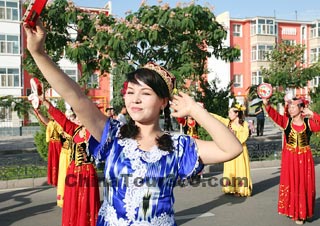The Uigur, with a total population of 8,399,393(in 2000), have lived at the foot of Mt. Tianshan for several centuries. They used to colonize in the north and northwest region of China, suffering from the wars between tribes, before migrating to the Western Regions (present Xinjiang).
 |
| Uigur People in Traditional Costume |
The origin of Uigur ethnic group can be traced back to the nomadic people living around Lake Baikal and the area between the Irtish River and Lake Balkhash in the third century B.C. During the long history, these people amalgamated the north and south Xinjiang, Mongolian, Han and Tibetan clans. And the present Uigur ethnic group came into being.
The Uigur has its own language and alphabet, which belongs to the Turki Austronesian, Altai Phylum. In their language, Uigur means solidification and union. The Uigurs rely heavily on agriculture as their main source of survival. They plant cotton, wheat, corn and paddy. The largest grape base of China is also located in the Turpan Basin.
The Uigurs are believers of the Islamic faith, which influences family life, marriages, food, finery and customs. In their daily diet, cooked wheaten food is their staple food, which includes nang, lamian (pulled noodle), zhuafan and baozi (steamed stuffed buns). The Uigurs favor beef, mutton, chicken, duck and fish as the meat in their diet. Fruits also play an important role in their life.
The Uigur dress follows a unique style. The men often wear an unbuttoned robe outside their shirt with square webbing tied around their waist. The women like fresh and brightly colored clothes. Their favorite accessories include earrings, bracelets and necklaces. All the people, young or old, man or woman, all favor the Russian boot and tetragon cap embroidered with black and white or colored silk threads in traditional Uigur designs. Young girls like to comb their hair into a dozen pigtails, since long hair is regarded as a part of the feminine beauty. After marriage, women usually wear two pigtails with loose ends, decorated on the head with a crescent shaped comb.

Singing and Dancing of Uigur Minority
The Uigurs are known for their skill in singing and dancing. On festive days and at gatherings of friends and relatives, Uigurs love to sing and dance. Their lively dances demonstrate diligence, bravery, openness and optimism. These dances are also characterized by unique head and wrist movements. Their clever coordination is enhanced by the typical posture of tilted head, thrust chest and erect waist.
The Corban Festival, Almsgiving Festival, Kaizhai Festival and Nuolu Festival are their most important festivals to the Uigur people.
Kaizhai Festival: According to Islamic calendar, the month of fast lasts from the first day of the ninth month to the first day of the tenth month of each year. During this period, eating and drinking are forbidden in the daytime. At the last day of fast, namely the first day of the tenth month, all Moslems, after bath, would go to mosque to pray and hold a series of celebrating activities.
Guerbang Festival: also named Zaisheng Festival, comes 70 days after Kaizhai Festival and is the most important festival. During this festival, some livestock are killed as sacrifices to the Allah.







